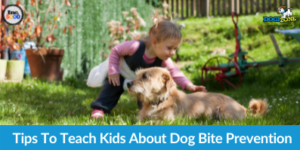Tips To Teach Kids About Dog Bite Prevention
Children who have dogs at home or have a history of positive interactions with dogs tend to see every canine as a friendly companion, but it’s important to teach them about dog bite prevention. While parents want children to grow up with a love of dogs and comfort in interacting, it is also important to teach kids how to reduce their risk of dog bites from both familiar and strange dogs they may encounter.

Teaching children what to do if they see a strange dog is the first step in dog bite prevention. While any dog can potentially bite if it is threatened or feels trapped or cornered, most dog bites occur when children come in contact with strange, unknown dogs.
Stray Dogs
Stray dogs are often very nervous, afraid, and uncertain of new people and new surroundings. While some stray dogs are exceptionally friendly and well-mannered, the best way to work with kids is to provide simple guidelines that are easy to remember and follow. Increasingly in urban areas, feral dogs are
The most effective way to prevent bites from strays is for children to learn not to approach or attempt to pet or catch any stray dog. Instead, teach children to walk away from the stray and tell Mom or Dad where the stray was located. This allows the parents to call animal control or check in on the dog without encouraging the child to interact with the animal.
If a stray dog approaches on its own, teaching the child what to do is important. The child should know to walk away calmly and avoid yelling, swinging, or making any sudden movements. They should never start to run as they cannot outrun a dog, and it only increases the chances of the dog chasing and increasing the aggression. If the dog follows or gets closer, standing completely still with their hands down at their sides can help to de-escalate the situation. Children should know to walk to a house for help if one is nearby.
Should the child be knocked down by the dog, he or she should curl into a ball and cover their face and neck with their arms and hands. This is the most defensive position if the child is unable to stand up.
Strange Dogs with Owners
At the dog park, on a walk, or even spending time at a campground provides a lot of opportunities for your kids to come in contact with unknown dogs and unknown owners. If this is a first-time meeting, teach children to ask the owner if they can pet the dog before approaching. Many dogs are not raised with kids, and they may be nervous or even overwhelmed children.
Even if the dog and owner are familiar, it is still a good policy for the child to ask to pet the dog. This alerts the owner to focus on watching the dog and sensing any possible reaction the dog may have to the child.
For family pets and familiar dogs, children should be taught to give the dog space. This means leaving the dog alone if it is in its crate or in the dog bet. Also, teach children to leave the pet alone when the pooch is eating and avoid teasing the dog with toys or food, even if the child intends it as a game.
For even more tips from our own dog training experts, watch this episode of our Ask the DogiExperts, where we shared tips on dog bite prevention.

